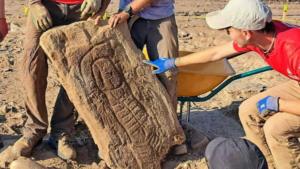
In southwestern Spain, a millennia-old funerary stone slab, recently discovered in the burial complex of Las Capellanías in Cañaveral de León, challenges traditional interpretations of gender and social roles in ancient societies. These commemorative stones, known as “stelae,” are widespread in various ancient cultures, such as Egypt and Central America, often serving as gravestones adorned with engravings, text, and paint, believed to depict significant individuals.
Unearthed by a team co-directed by Dr. Marta Diaz-Guardamino of Durham University, the 3000 year old slab features an intricately engraved human figure with distinct facial features, hands, and feet. The adorned figure wears a headdress, necklace, and notably, two swords. Previously, depictions of a headdress and necklace on stelae were assumed to represent females, while the inclusion of weapons like swords was interpreted as portraying a male “warrior” stela.
Crucially, the engraved human on the Spanish funerary stone exhibits male genitals, challenging the previously perceived binary nature of prehistoric social and gender roles depicted in such carvings. This discovery provides valuable insights into the funerary rituals of the Bronze/Iron Age. The Las Capellanías funerary complex, now yielding three such artifacts, contributes significantly to our understanding of burial practices and cultural customs from that era.
Decorated stelae dated to the period 1250 to 700 B.C. are already rare artifacts in Europe, according to Díaz-Guardamino. But the latest find is even more remarkable in that it represents the first time a stela combining the traits of the warrior and headdress figures has been found—not to mention the fact that it was found in its original context.
As we delve deeper into the mysteries of our ancient past, the Las Capellanías discovery serves as a testament to the dynamic nature of prehistoric societies. It prompts us to reconsider and broaden our understanding of social structures, and the multifaceted roles of cultural artifacts in shaping the narratives of bygone eras.
